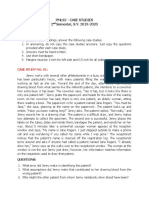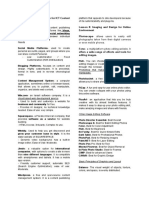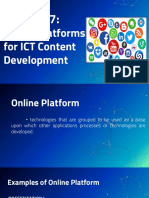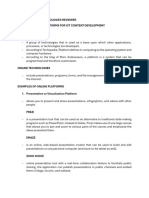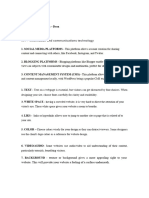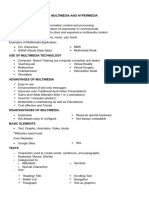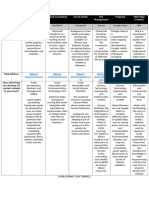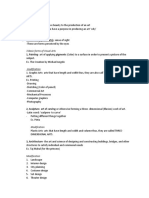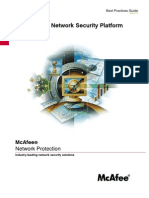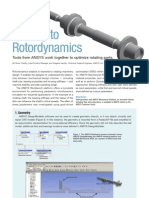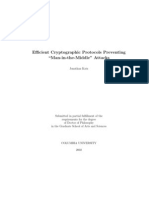A. Imaging and Design For Online Environment
A. Imaging and Design For Online Environment
Uploaded by
Jacqueline DonatoCopyright:
Available Formats
A. Imaging and Design For Online Environment
A. Imaging and Design For Online Environment
Uploaded by
Jacqueline DonatoOriginal Description:
Original Title
Copyright
Available Formats
Share this document
Did you find this document useful?
Is this content inappropriate?
Copyright:
Available Formats
A. Imaging and Design For Online Environment
A. Imaging and Design For Online Environment
Uploaded by
Jacqueline DonatoCopyright:
Available Formats
A.
IMAGING AND DESIGN FOR ONLINE ENVIRONMENT
VISUAL INFORMATION - use of visual media in the form of photographs, motion pictures, video
recordings, graphic arts, visual aids, and other displays that use pictorial representations.
IMAGE - Pictures that depict some real-world situation typically captured by camera; sometimes
called Raster or Bitmap images.
GRAPHICS - Pictures drawn or painted that depict any fictitious scenario; Vector images.
VECTOR – hard-edged graphics; for printing; .ai, .pdf, .svg
RASTER – web graphics; high-resolution; can be printed at 300 dpi; .jpg, .png, .gif
B. COMMON DIGITAL IMAGE FILE FORMATS
DIGITAL IMAGE - a numeric representation, normally binary, of a two-dimensional image
IMAGE FILE FORMATING - standardized means of organizing and storing digital images
JPEG / JPG (Joint Photographic Experts Group) – compressed to store a lot of information in a small-
size file; most digital cameras store photos in JPEG; usually used for photographs on the web, because
they create a small file that is easily loaded on a web page
PNG (Portable Network Graphics) – supports transparency; for web browsers; for icons, graphics, logo
GIF (Graphics Interchange Formats) – supports transparency; provides image animation effects
TIFF (Tagged Image File Format) – used in photo software, as well as page layout software
C. BASIC PRINCIPLES OF GRAPHICS AND LAYOUT
LAYOUTING (Computing) – process of calculating the position of objects in space; process of planning
and arranging visual elements in a page or book
BALANCE – even distribution
EMPHASIS – attract
MOVEMENT – guide the viewer’s eyes
PATTERN, REPETITION, RHYTHM – repeating an element on an image or layout to create unity
PROPORTION – visual elements create a sense of unity when they relate well with one another
VARIETY – uses several design elements to draw viewer’s attention
D. BASIC TECHNIQUES OF IMAGE MANIPULATION
IMAGE MANIPULATION – art of altering or modifying an image for different purposes using various
techniques or using a photo editing software
BENEFITS OF IMAGE MANIPULATION:
Create beautiful images
Enhance your looks in a photograph
Spread a social message via images
TECHNIQUES:
RESIZING – width and height specify dimensions after resizing (proportions are not preserved)
SCALING – resolution is not adjusted to best suit the new size; pixels are stretched; pixelated
CROPPING – eliminates the non-photographic area
FLIP – object turns over, either vertically or horizontally; mirror image
ROTATE – moves left or right around an axis and keeps the same face toward you
COLOR ADJUSTMENT – changes overall mixture of colors for generalized color correction
BRIGHTNESS AND CONTRAST
FILTERS & EFFECTS
COMBINING TEXT AND IMAGE
E. INFOGRAPHICS
Information + graphics
are graphic visual representations of information, data or knowledge intended to present information
quickly and clearly
F. UPLOADING, SHARING AND IMAGE HOSTING PLATFORM
UPLOADING – process
SHARING – convey message
HOSTING – create photoblogs/galleries with your images, or add them to a slide show for easier viewing
G. ONLINE PLATFORMS
technologies that are grouped to be used as a base upon which other applications processes or
technologies are developed
Presentation Tools – slide show
Cloud Computing – online storage
Mapping Tools – creation of maps
File Management platforms – user interface to manage file and folder
Social Media – create not only personal accounts but also pages and groups
Blogging – newsletter; article
Web Page Creation – for WWW, web browsers; HTML
CMS (Content Management System) – manages the creation and modification of web contents
H. BASIC WEB PAGE CREATION
WEBPAGE – stored in HTML file
WEBSITE – collection of webpages
HTML – defines the content of every web page; Structural layer
CSS – used to style webpages; Presentation layer
JAVASCRIPT – behavior/functionality
WYSIWYG (What You See Is What You Get) – whatever you type, insert, draw, place, rearrange, and
everything you do on a page is what the audience will see
I. COLLABORATIVE ICT DEVELOPMENT
WEB PORTAL – web-based platform that brings information from diverse sources, like emails, online
forums and search engines, together in a uniform way
ONLINE COLLABORATION lets a group of people work together in real-time over the internet for the
team to accomplish its goals
supports a group or two or more individual to accomplish a common goal
supports the storing of files in a single place
supports significant cost savings
J. INTERACTIVE MULTIMEDIA
products & services on computer-based systems which respond on user’s actions by presenting content
MULTIMEDIA – combination of different media
Videos - with video hosting sites, you can take a video and show it to the entire world (YouTube)
Sound, Music, or Audio - If videos are too much for you, you can always record sounds. You
can now share your sound bites to the entire world (e.g., Soundcloud).
Online games - “browser-based games” - You do not need to install these games to your
computer as they run in most updated web browsers
Online tests - Online survey forms and tests that automatically display the results when finished
Courseware - Online courses that simulate the classroom online (e-learning Courses using LMS)
Podcasts - An episodic series of audio or text files streamed online
Vodcasts - An episodic series of video streamed online
K. ICT AS PLATFORM FOR CHANGE
EDSA UNO – used Radyo Veritas
EDSA DOS – used text message
MILLION PEOPLE MARCH – used Facebook
GOOGLE PERSON FINDER – created by Google
CHANGE.ORG – dubbed as the world’s platform for change where anyone from the online community
can create a petition and ask others to sign it
You might also like
- Case Studies & Lab ActivitiesDocument5 pagesCase Studies & Lab ActivitiesJacqueline Donato100% (1)
- Em-Tech ReviewerDocument2 pagesEm-Tech ReviewerKai SamaNo ratings yet
- Etech Final TermDocument2 pagesEtech Final TermCie KayNo ratings yet
- Em-Tech ReviewerDocument3 pagesEm-Tech ReviewerKai SamaNo ratings yet
- E-Tech: ICT (Information and Communication Technology) - The Use of Different CommunicationDocument7 pagesE-Tech: ICT (Information and Communication Technology) - The Use of Different CommunicationBren ArnigoNo ratings yet
- Empowerment Technology - Reviewer Quarter 2Document5 pagesEmpowerment Technology - Reviewer Quarter 2Karl Vincent Nonog100% (1)
- Empowerment Technology - Reviewer Quarter 2Document5 pagesEmpowerment Technology - Reviewer Quarter 2Karl Vincent NonogNo ratings yet
- MS PPT and Presentation Handout 2Document4 pagesMS PPT and Presentation Handout 2Killes SmileNo ratings yet
- Emptech R Q3Document12 pagesEmptech R Q3Maysheil GalarceNo ratings yet
- Excel Second Quarter ReviewerDocument1 pageExcel Second Quarter Reviewerjaysaalilano88No ratings yet
- E Tech ReviewerDocument3 pagesE Tech ReviewerKrishian Erl AndogNo ratings yet
- Emtech ReviewerDocument4 pagesEmtech ReviewerJopay GagatigaNo ratings yet
- Lesson 7:: Online Platforms For ICT Content DevelopmentDocument32 pagesLesson 7:: Online Platforms For ICT Content DevelopmentIla SerelloNo ratings yet
- Emtech Reviewer FinalDocument5 pagesEmtech Reviewer Finalrrhmnq68h5No ratings yet
- Emtech Second QuarterDocument7 pagesEmtech Second QuarterMarc Lawrence LagascaNo ratings yet
- Empowerment Technology: Week 5Document2 pagesEmpowerment Technology: Week 5Kaye OsalNo ratings yet
- EmTech Reviewer Module 3 4Document5 pagesEmTech Reviewer Module 3 4seanreyes30No ratings yet
- 2ND Quarter Et ReviewerDocument8 pages2ND Quarter Et ReviewerAubrey AlcosebaNo ratings yet
- Finals Emptech ReviewerDocument3 pagesFinals Emptech ReviewerClaudine ConcepcionNo ratings yet
- Computer Science ReviewerDocument4 pagesComputer Science ReviewerAvril RegalaNo ratings yet
- Lesson 6 - Imaging and Design For Online EnvironmentDocument16 pagesLesson 6 - Imaging and Design For Online EnvironmentCecille Pagana92% (13)
- Rhythm To Form. Patterns Are Nothing MoreDocument5 pagesRhythm To Form. Patterns Are Nothing MoreAlliyah LimosNo ratings yet
- Advanced Spreadsheet SkillsDocument13 pagesAdvanced Spreadsheet SkillsLili PangitNo ratings yet
- PointerDocument8 pagesPointerDonamae D. DelacruzNo ratings yet
- Emtech FinalsDocument7 pagesEmtech FinalsNova GamingNo ratings yet
- Empowerment Week 5Document6 pagesEmpowerment Week 5Alva RedoñaNo ratings yet
- Emtech Reviewer Pagod NakoDocument9 pagesEmtech Reviewer Pagod NakoJAMES GAMERNo ratings yet
- Collaborative Ict Development: ExamplesDocument4 pagesCollaborative Ict Development: ExamplesVicky PungyanNo ratings yet
- Q2 - Emtech - Week1 - Online PlatformDocument21 pagesQ2 - Emtech - Week1 - Online PlatformMajella AtazarNo ratings yet
- Emptech: Online Platforms For ICT Content DevelopmentDocument4 pagesEmptech: Online Platforms For ICT Content Developmentmariane cabillasNo ratings yet
- Online Tools For Content DevelopmentDocument4 pagesOnline Tools For Content DevelopmentK-yanVehraaYomomaNo ratings yet
- Educ Tech 2 Chapter 12Document2 pagesEduc Tech 2 Chapter 12SerryAlbercaNo ratings yet
- Summarized ModulesDocument13 pagesSummarized ModulesGarabel TintinNo ratings yet
- Notes EtechDocument8 pagesNotes EtechRaine ReaallNo ratings yet
- Reviewer Empowerment Technology FinalsDocument3 pagesReviewer Empowerment Technology Finalssalaban dossNo ratings yet
- Lesson 5 Imaging and Design For Online EnvironmentDocument2 pagesLesson 5 Imaging and Design For Online EnvironmentKaizel BritosNo ratings yet
- Technology in Education Technology Presentation in Blue Peach Illustrative - 20240419 - 214356 - 0000Document34 pagesTechnology in Education Technology Presentation in Blue Peach Illustrative - 20240419 - 214356 - 0000alexanlousumanNo ratings yet
- Online Platforms As Tools For Ict Content DevelopmentDocument57 pagesOnline Platforms As Tools For Ict Content Developmentmarry jane100% (2)
- Summary of Lessons (2ndquarter)Document4 pagesSummary of Lessons (2ndquarter)Marlowe MarquezNo ratings yet
- Empowerment Technologies ReviewerDocument3 pagesEmpowerment Technologies ReviewerKyle SumicadNo ratings yet
- MMA111 Quiz ReviewerDocument11 pagesMMA111 Quiz ReviewerTristanNo ratings yet
- Ccs352 Unit 3Document15 pagesCcs352 Unit 3reshma.rNo ratings yet
- LESSON 6 Online ICT Platforms As Tools For ICT Content DevelopmentDocument2 pagesLESSON 6 Online ICT Platforms As Tools For ICT Content DevelopmentKaizel BritosNo ratings yet
- Empotech Module 7 CCDocument25 pagesEmpotech Module 7 CCRaymon BoncacasNo ratings yet
- Chapter 12 Web Edtech ReportDocument63 pagesChapter 12 Web Edtech ReportSara Mae Tom100% (1)
- ETECH SF ReviewerDocument5 pagesETECH SF ReviewerLester CaladoNo ratings yet
- ETECHDocument3 pagesETECHPrincess Cherry C. EstradaNo ratings yet
- Lesson 8Document2 pagesLesson 8ITZDUSTY gamerNo ratings yet
- ITIKKDocument5 pagesITIKKKen Juliana Fe IsaacNo ratings yet
- Chapter 3 - The Role of Multimedia in EducationDocument37 pagesChapter 3 - The Role of Multimedia in EducationGellie Ann Silvestre RapinNo ratings yet
- Empowerment Module Week 7 and 8Document5 pagesEmpowerment Module Week 7 and 8jcriztineNo ratings yet
- Application SoftwareDocument3 pagesApplication SoftwareAhnNo ratings yet
- Basic Application Software MspowerpointDocument21 pagesBasic Application Software MspowerpointlinaNo ratings yet
- Etech-Week-7-8 NewDocument7 pagesEtech-Week-7-8 NewStella Marie Carpina CominguezNo ratings yet
- Empowerment Technologies ReviewerDocument6 pagesEmpowerment Technologies ReviewerJaye CarreonNo ratings yet
- Types of Authoring ToolsDocument18 pagesTypes of Authoring ToolsZacardious DhanrajNo ratings yet
- Publishing PlatformsDocument1 pagePublishing Platformstyleryt023No ratings yet
- The Nature and Purpose of Online Platform and Application: Christine G. Nivera, LPT Teacher IIDocument34 pagesThe Nature and Purpose of Online Platform and Application: Christine G. Nivera, LPT Teacher IIChristine Nivera-PilonNo ratings yet
- Etech ReviewerDocument5 pagesEtech ReviewerjainahnoolNo ratings yet
- Reviewer in EmpowermentDocument2 pagesReviewer in EmpowermentAo GaveNo ratings yet
- Jumpstart UIKit: Learn to Build Enterprise-Level, Feature-Rich Websites that Work Elegantly with Minimum FussFrom EverandJumpstart UIKit: Learn to Build Enterprise-Level, Feature-Rich Websites that Work Elegantly with Minimum FussNo ratings yet
- Name Course/Year/Section Subject 2 Semester AY 2019-2020 Title of ArticleDocument1 pageName Course/Year/Section Subject 2 Semester AY 2019-2020 Title of ArticleJacqueline DonatoNo ratings yet
- Matrix On Sleep DeprivationDocument33 pagesMatrix On Sleep DeprivationJacqueline DonatoNo ratings yet
- CPARDocument6 pagesCPARJacqueline DonatoNo ratings yet
- Background of The Study: Bataineh, 2014)Document10 pagesBackground of The Study: Bataineh, 2014)Jacqueline DonatoNo ratings yet
- Background of The Study: Bataineh, 2014)Document10 pagesBackground of The Study: Bataineh, 2014)Jacqueline DonatoNo ratings yet
- Configuring The Kernel: Buddhika Siddhisena Co Founder & Cto Thinkcube Systems Pvt. LTDDocument19 pagesConfiguring The Kernel: Buddhika Siddhisena Co Founder & Cto Thinkcube Systems Pvt. LTDMartins STiNo ratings yet
- Assign 01Document2 pagesAssign 01arunabh bhattacharyaNo ratings yet
- Synopsis On Hotel Management System IntrDocument21 pagesSynopsis On Hotel Management System Intrjayesh tahasildarNo ratings yet
- XML ParserDocument7 pagesXML ParserPravin ReddyNo ratings yet
- Oops Lab ManualDocument44 pagesOops Lab ManualAnbazhagu VeerasamyNo ratings yet
- Microprocessor OperationDocument6 pagesMicroprocessor Operationrooopes5No ratings yet
- WLC UpgradeDocument13 pagesWLC Upgradeapi-3703368No ratings yet
- Common Issues With Oracle Text Search On The Content Server - OTS - Oracle Text SearchDocument3 pagesCommon Issues With Oracle Text Search On The Content Server - OTS - Oracle Text SearchJuan TmtestmeNo ratings yet
- UCCD1024 Lecture3 Advanced Struct UpdatedDocument37 pagesUCCD1024 Lecture3 Advanced Struct Updated添シュン Ice lemonNo ratings yet
- Block Ciphers: Dr. Md. Mahbubur RahmnaDocument124 pagesBlock Ciphers: Dr. Md. Mahbubur RahmnaimtibdNo ratings yet
- Technology PLSQL by Steven FeuersteinDocument119 pagesTechnology PLSQL by Steven Feuersteinmshoaib76No ratings yet
- Mcafee® Network Security PlatformDocument48 pagesMcafee® Network Security PlatformJoe SaviniNo ratings yet
- Hitag-2 Key ProgDocument10 pagesHitag-2 Key ProgVASEKNo ratings yet
- Nosql Database: AbstractDocument6 pagesNosql Database: AbstractharshavyawahareNo ratings yet
- PythonDocument68 pagesPythonRon NecesitoNo ratings yet
- C and C++ NotesDocument134 pagesC and C++ NotesSean NormanNo ratings yet
- CCNP Security at TnLExperts PDFDocument17 pagesCCNP Security at TnLExperts PDFyazdan kundiNo ratings yet
- Documentation On BloodbankDocument99 pagesDocumentation On BloodbankSwamy100% (1)
- AA V4 I2 Turning To Rotor DynamicsDocument2 pagesAA V4 I2 Turning To Rotor DynamicsJan MacajNo ratings yet
- DRBD Activity Logging v6Document5 pagesDRBD Activity Logging v6salamsalarNo ratings yet
- Cloudera Releases PDFDocument185 pagesCloudera Releases PDFAnonymous LIRwTvFNo ratings yet
- Bapi Material Stock Req ListDocument5 pagesBapi Material Stock Req Listvikas_1193No ratings yet
- Vendor Invoice Booking-MIRODocument5 pagesVendor Invoice Booking-MIROAMIT SAWANTNo ratings yet
- Programming Language and Compiler Design SessionDocument33 pagesProgramming Language and Compiler Design Sessionmeeraneela0808No ratings yet
- Data Center QuestionnaireDocument7 pagesData Center QuestionnairerahilsusantoNo ratings yet
- Efficient Cryptographic Protocols Preventing "Man-in-the-Middle" Attacks, PHD Thesis, Jonathan KatzDocument167 pagesEfficient Cryptographic Protocols Preventing "Man-in-the-Middle" Attacks, PHD Thesis, Jonathan KatzTa Thanh Dinh100% (1)
- Intranet Chatting AbstractDocument6 pagesIntranet Chatting AbstractTelika RamuNo ratings yet
- Fixed Point Arthimetic BasicsDocument21 pagesFixed Point Arthimetic BasicsUkasha LarbiNo ratings yet
- Assembly Language Crash CourseDocument7 pagesAssembly Language Crash CourseMacs InfotechNo ratings yet
- ETP Specs ReviewDocument3 pagesETP Specs Reviewif05041736No ratings yet
